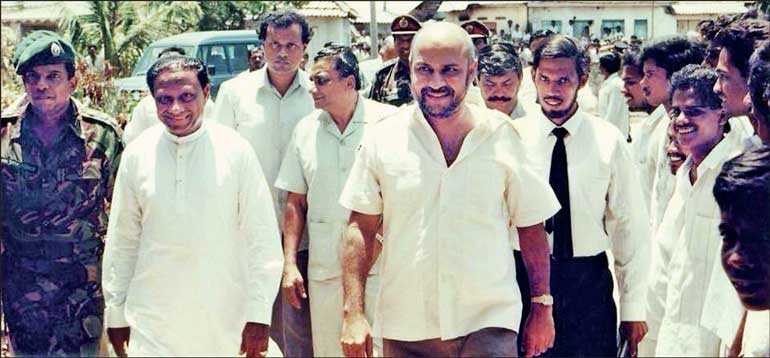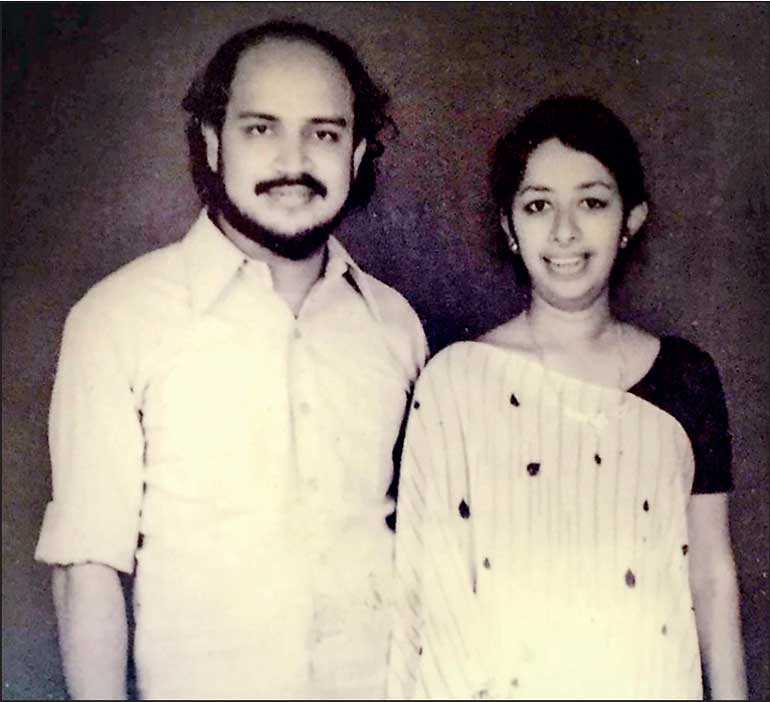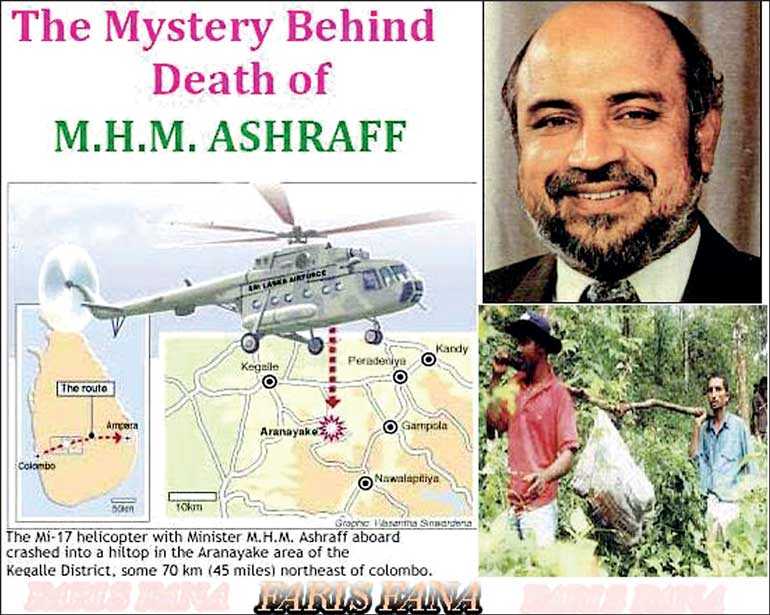Friday Nov 28, 2025
Friday Nov 28, 2025
Wednesday, 16 September 2020 00:30 - - {{hitsCtrl.values.hits}}

Ashraff’s demise created a vacuum in Muslim politics that is yet to be filled, even two decades later

Ashraff and Ferial. Ferial, who was a tower of strength to her husband, entered active politics after his death

Today (16 September) is the 20th death anniversary of Mohammad Hussein Muhammad Ashraff, the legendary leader of the Sri Lanka Muslim Congress (SLMC). He was the Cabinet Minister in charge of Shipping, Ports, Reconstruction and Rehabilitation in the Government of President Chandrika  Bandaranaike Kumaratunga at the time of his death. He, along with 14 others, was killed in an air crash on 16 September 2000.
Bandaranaike Kumaratunga at the time of his death. He, along with 14 others, was killed in an air crash on 16 September 2000.
M.H.M. Ashraff had on that fateful morning boarded a Sri Lanka Air Force (SLAF) Mi-17 helicopter at the Police grounds in Bambalapitiya at about 9:30 am. Nine SLMC party officials and three bodyguards accompanied Ashraff. There were also two crew members from the SLAF. The flight destination was Ampara/Amparai.
Forty-five minutes later Air Traffic controllers lost radio contact with the helicopter being flown by squadron leader Shiran Perera. It was later discovered that the chopper had crashed over the Urakanda mountain range in the Aranayaka area in Kegalle District of Sabaragamuwa Province. Fifteen charred bodies were recovered from the burning wreckage. Ashraff’s funeral was held late night on the same day at Colombo’s Jawatte Muslim burial ground. He had earlier told family members that he should be buried within hours of his death.
Two decades have passed since his death but there is no denying that the demise of Ashraff has created a vacuum in Muslim politics that is yet to be filled. Even 20 years later the memory of Ashraff and the impact of his legacy continue to exert significant influence over the politics of Sri Lankan Muslims in general and the Muslim Congress in particular.
It is a given that any Muslim politician in the east who wants to avoid loss of popularity, retain popularity or gain more popularity must always praise the magic name of Ashraff. No Muslim politico dares to be politically critical of Ashraff in the “Kizhakku Maahaanam” (Eastern Province) for fear of being politically ostracised.
Prevailing political mystique of ‘Marhoom’ M.H.M. Ashraff
What then is the reason for the prevailing political mystique of “Marhoom” M.H.M. Ashraff? He was far ahead of his time in more ways than one. Ashraff realised the vast untapped political potential of his
 |
| Until death M.H.M. Ashraff remained the undisputed “Thesiya Thalaiver” (National Leader) of the north-eastern Muslims
|
community and strove to charter a course that would have enabled his people to have their rightful place under the sun.
The pioneering President of the SLMC was Ahammed Lebbe of Kattankudy with whom Ashraff co-founded the party in September 1981. It was however M.H.M. Ashraff who gave the Muslim Congress a new vision and direction after he assumed formal leadership of the party in 1986.
Thanks to Ashraff’s visionary zeal and missionary energy the SLMC achieved many, many things during the 15 years he was at the party’s helm. His charisma, political acumen, dedication and sterling qualities of leadership enabled Ashraff to mould the long-overlooked eastern Muslims into a viable political entity.
At a time when the conflict within the island was perceived in simplistic terms as a “Sinhala versus Tamil” issue, the efforts of Ashraff brought to the fore the problems faced by Muslims. The eloquent and effective advocacy of the Muslim cause by Ashraff led to a general awareness that the seemingly intractable ethnic crisis was not merely a Sinhala-Tamil bilateral issue but a trilateral one involving Muslims too.
Muslims of Sri Lanka and their unique ethnic identity
The Muslims of Sri Lanka, also known as Moors, have a unique ethnic identity. Constituting 9.6% of the island’s population, they are distributed somewhat evenly with about two-thirds of them in the seven predominantly Sinhala provinces and the rest in the Tamil majority north and east.
The bulk of the community including sections living amidst the Sinhala population speaks Tamil at home and are classified as Tamil speaking. The medium of instruction in most Muslim schools is chiefly Tamil. The community has also thrown up a number of Tamil scholars, writers, poets, journalists and artistes who have reached eminent positions.
In spite of this, the community does not perceive itself as being “Tamil” but “Muslim”. The Muslim self-perception is based on ethno-religious lines and not ethno-linguistic lines. This socio-cultural reality has acquired sharp political dimensions in recent times.
Although they are a scattered population, Sri Lankan Muslims have their single largest concentration in the Eastern Province. A large number of Muslims of the Batticaloa-Amparai Districts live interspersed among Tamil villages along the littoral areas known as “Eluvaankarai” (Coast of the Rising Sun). The hinterland to the west of Batticaloa lagoon known as “Paduvaankarai” (Coast of the Setting Sun) is predominantly Tamil.
The east consisting of Muslim “enclaves” with substantial Muslim votes has helped the Eastern Province Muslims to elect at least four to seven Parliamentarians from the province at each election. The eastern “bloc” has at times constituted almost 50% of the total Muslim representation in Parliament.
Despite this advantage, the overall leadership of the community was not in the hands of the eastern Muslim for many years. The comparatively advanced Muslim leaders from the Central, Western and Southern Provinces were in charge, lording it over the Muslims from the eastern backwaters. All this, however, changed with the arrival of Ashraff.
The arrival of M.H.M. Ashraff
Ashraff was born on 23 October 1948 in the Muslim village of Sammanthurai in Amparai District. His parents were Mohammed Meera Lebbe Hussain and Matheena Ummah. He grew up in the town of Kalmunai, in the same region.
After schooling in Kalmunai, Ashraff entered Law College where he passed the examination with first class honours. He worked briefly as a State Counsel at the Attorney General’s Department but resigned and reverted to the unofficial bar. Ashraff went on to acquire a Bachelor’s and later a Master’s degree in Law from Colombo University. The latter feat was achieved in 1995 when he was a Cabinet Minister. He took silk in 1997 as President’s Counsel.
Ashraff married Ferial Ismail, hailing from Gampola. They met on a train and fell in love. Ferial who was a tower of strength to her husband entered active politics after his death. Ferial Ashraff made history as the first Muslim woman to be a Cabinet Minister. She held various portfolios at different times such as Housing, Construction, Common Amenities, Industries and Education Development in the Eastern Province under former Presidents Chandrika Kumaratunga and Mahinda Rajapaksa. Ferial also served as High Commissioner to Singapore. Ashraff and Ferial’s only son Aman runs his own advertising agency in Colombo.
Though an uncompromising Muslim nationalist in later years, Ashraff was always close to the Tamil language and its ethos. As an old student of Wesley High School in Kalmunai and as a law student he moved closely with Tamils. Despite the vagaries of politics he retained his personal friendships with Tamil classmates and colleagues. He was also well-versed in the Tamil language and literature. Ashraff published a magazine in his younger days named ‘Samathuvam’ (Equality). He also was a freelance contributor to the Tamil daily ‘Dinapathy’.
Ashraff was a fiery orator in Tamil. Moreover he was also a poet using “Thamizh” as the vehicle of his thoughts. The volume of poetry ‘Naan Ennum Nee’ published by him was commendable though not superlative as his sycophants portrayed them to be. In any case few of the present crop of Tamil-Muslim parliamentarians read poetry let alone compose poems.
He began his political career as an admirer of the Tamil father figure S.J.V. Chelvanayagam, the co- founder leader of the ‘Ilankai Thamil Arasuk Katchi’ or Federal Party. He was greatly enamoured of Chelvanayagam and the federalist vision for the Tamil-speaking people of the North-Eastern Provinces.
Ashraff was particularly appreciative of the fact that it was Chelvanayagam who raised the issue of Muslims being killed at the Puttalam mosque by Sinhala policemen. Muslim Parliamentarians including then Puttalam UNP Parliamentarian Naina Marikkar maintained a deafening silence then.
Ashraff spoke on FP platforms and in 1976 attended the historic Vaddukkoddai Conference where the newly-formed Tamil United Liberation Front (TULF) unanimously adopted the demand for a separate state of Tamil Eelam.
Tamil Eelam
I first met Ashraff in 1977 when he was campaigning ardently for Tamil Eelam on the TULF platform. He had formed the Muslim United Front along with Lawyer A.M. Samsudeen of Kalmunai and signed an agreement with Appapillai Amirthalingam of the TULF. Muslim candidates were fielded on the TULF Sun symbol in Kalmunai, Sammanthurai, Puttalam and Mutur.
Another assigned to contest Seruwila failed to submit nomination papers at the last minute. Ashraff himself did not contest but actively campaigned in 1977. This was the time when Ashraff stated publicly that even if elder brother Amirthalingam could not deliver Tamil Eelam, younger brother Ashraff would do so. The highlight of Ashraff’s speeches then was his bombastic pronouncement that even if Amirthalingam himself abandoned the goal of Eelam, Ashraff would continue to strive for it.
In spite of this affinity towards Tamil Eelam on the part of Ashraff, the eastern Muslim voters had different ideas and rejected the MUF candidates on the TULF ticket. The electoral results showed that despite Ashraff’s desire to share a Tamil-Muslim political vision, eastern Muslims had other ideas. While the Tamil candidates of the TULF swept the polls, no Muslim from the MUF won a seat in the 1977 polls. This was an eye-opener to Ashraff.
His relations with the TULF became strained gradually. The 1981 District Development Council elections saw the TULF going to polls in Mannar and the three eastern districts on a Tamil slate of candidates. Ashraff wanted Muslims to be included too. He was rebuffed. This led to an already-estranged Ashraff parting ways with the TULF completely.
However this did not result in him joining a “Sinhala-dominated” national party like other Muslim leaders of old who cut their political teeth in the FP and then merrily crossed over after winning elections. Ashraff realised that the Muslims needed to charter a separate course independent of Tamil and Sinhala politics. This led to his aligning with Ahammed Lebbe of Kattankudi and co-founding the Muslim Congress. The SLMC was inaugurated on 21 September 1981. At that point, the SLMC was more or less an eastern outfit concerned more with socio-cultural matters than political issues.
The July 1983 anti-Tamil pogrom and the consequent escalation of armed Tamil militancy led to a situation where the possibility of Tamil Eelam began looming large on the political horizon. The eastern Muslims became increasingly insecure and apprehensive of their future in a potential “Tamil” state.
On the other hand, the contemptuous manner in which the J.R. Jayewardene regime dismissed the Muslim opposition to the resumption of diplomatic relations with Israel touched a raw nerve in the community. Ashraff was instrumental in organising protest demonstrations over the issue. However, Sri Lankan Muslims at that point of time were immune from the global trend of growing Islamic consciousness and radicalism.
Traditionally substantial numbers of eastern Muslims were farmers, fisher-folk or traders. However the Muslim community in the east also produced a new generation of educated and ambitious youth. All this created a suitable climate for Ashraff and his brand of politics to arrive on the national scene. The rise of Tamil armed militancy instilled a sense of political urgency into Muslim politics.
The catalyst was the outbreak of violence between Tamils and Muslims in the Kalmunai-Karaitheevu areas in 1985 which was aided and abetted by agents of the state and Tamil militant groups. The Kalmunai-Karaitheevu Tamil-Muslim violence of 1985 affected Ashraff directly. Threatened by and fearing harm at the hands of Tamil militants, Ashraff was forced to flee to Colombo.
Revival and restructuring of Muslim Congress
Ashraff moving to Colombo as a “political refugee” was a significant milestone in his life. In the nation’s capital, Ashraff’s political horizons began to extend beyond the east. He recognised the widespread disappointment prevalent among the Muslim masses with their elitist leaders. Ashraff identified the need and yearning of the community to assert boldly and articulate their identity. Ashraff was disgusted with the politics of Muslim leaders in the UNP and SLFP.
Establishing himself firmly in Colombo Ashraff, revived and restructured the Muslim Congress. On 29 November 1986 he convened an islandwide convention in Punchi Borella and formally took over party leadership after gently easing out Ahamed Lebbe. I was a witness to this eventful moment in the history of the Muslim Congress. I attended the convention in a journalistic capacity along with my departed friend and colleague M.P.M. Azhar of the ‘Virakesari’ who later edited the ‘Navamani’ Muslim weekly. There was magic in the air as the Muslim delegates took their decisive step on a long journey that still continues. I was in close contact with Ashraff during the 1986-’88 period. It was then that I saw him at close quarters, forging a new vision and mission for his people. Some of his ideals seemed impossible to achieve then. Ashraff wanted the Muslims to be recognised as a separate and equal entity on par with the Sinhala and Tamil people.
The Muslim people in all parts of the country needed their own independent political party. The SLMC was to fulfil that role. Ashraff gradually redefined the objectives and redrafted the Constitution of the Muslim Congress to make it an all-island party. It was formally accredited by the Election Commissioner and allocated the symbol of the tree on 11 February 1988.
The “new” SLMC under Ashraff contested the Provincial Councils in 1988. It won 17 seats in the North-East and 12 in the Western, North-Western, Central and Southern Provinces. The Proportionate Representation system helped the fledgling party to record an impressive showing in the Provincial Council Elections. The Muslim Congress had come of age.
Although he was not happy with the India-Sri Lanka Agreement of July 1987 which he felt neglected the Muslim viewpoint, Ashraff supported its provisions. The Muslim Congress participated in the North-East Provincial Council Elections of 1988 and became the chief Opposition party there to the administration headed by Annamalai Varatharajapperumal.
Ashraff’s adaptive flexibility
Apart from the charismatic sway Ashraff had over the Muslim masses, his strength was his adaptive flexibility. The SLMC’s fundamental demand had been for the creation of a territorially non-contiguous Muslim majority council consisting of the Muslim divisions in the north and east. Ashraff’s rationale in this issue was to preserve for the Eastern Province Muslims their 33% representation as far as possible in a proposed merger situation where it would have dwindled to 17%.
When he found the demand for a territorially non-contiguous unit unachievable, Ashraff substituted it for the South Eastern Provincial Council comprising the territorially contiguous electoral divisions of Sammanthurai, Pottuvil and Kalmunai. He was also willing to support a merger of Batticaloa and Trincomalee Districts with the Northern Province. He was prepared to give that up too if it became necessary and opt instead for a merged north-east with adequate safeguards for Muslims including a de-merger proviso by referendum in 10 years’ time.
Ashraff had to clash with Tamil politicians in later years in the interests of his community. This was inevitable. But unlike many of the current crop of Muslim politicians from the east, Ashraff had a genuine empathy with Tamil and Tamils. He understood Tamil grievances and appreciated their aspirations.
Ashraff also felt that the fundamental problem was Sinhala majoritarianism and that some understanding among minority communities was necessary to combat it. While being firm on Muslim interests, Ashraff was always ready to work together with Tamils. There are few eastern Muslim politicos on the same wavelength as that of Ashraff on this aspect today.
While the interests of his own community were paramount for him, Ashraff was also extremely sympathetic to the Tamil problems and grievances. Except where the interests of Tamils and Muslims clashed directly, he tried to help realise the legitimate aspirations of Tamils. He also arrived at an understanding to achieve a working relationship with the Ceylon Workers’ Congress representing Tamils of Indian origin.
The National Unity Alliance
Ashraff’s greatest virtue was perhaps his metamorphosis from a “sectarian” leader to a “national” one. Ashraff addressed a gathering of the SLMC High Command and Politburo members at the Taj Samudra Hotel in 1998 and stated: “As a party representing a minority in this country, we have reached the limits of our abilities. If we are to serve the nation and its people at a greater degree, we must then, now look to expand our horizons into national politics and aim to define a role for ourselves within.”
Ashraff formed the National Unity Alliance and registered it as a political party on 23 August 1999. He was now prepared to look beyond Muslim ethnicity and reach out to other communities. Ashraff had a blueprint for achieving lasting peace by 2012.The NUA’s birth indicated that the one-time “Tamil Eelamist” supporter who pioneered an exclusive party for Muslims had reached an evolutionary stage where his outlook was blossoming into a broader nationalist perspective.
While the SLMC was to be the flagship of the Muslims, the NUA was to be wider and inclusive, representing all communities. The 2000 elections saw candidates being fielded as both SLMC and NUA. One does not know what the future may have been of the SLMC and NUA, had Ashraff lived to implement his vision. Ashraff died a few weeks before the scheduled poll on 10 October 2000.
Seven MPs from SLMC and four from NUA entered Parliament. Sadly there was a split and the SLMC and NUA began functioning under the separate leaderships of Rauff Hakeem and Ferial Ashraff respectively. Ashraff’s life being snuffed out at a critical stage was a setback to the limitless possibilities offered by the National Unity Alliance grand vision.
Until death Ashraff remained the undisputed “Thesiya Thalaiver” (National Leader) of the north-eastern Muslims. Ashraff may be no more, but his spirit pervades Muslim political consciousness still. In life he was the single most popular mass figure in eastern Muslim politics. Even after death the magical hold he retained over Muslim masses lingers on.
(D.B.S. Jeyaraj can be reached at [email protected])